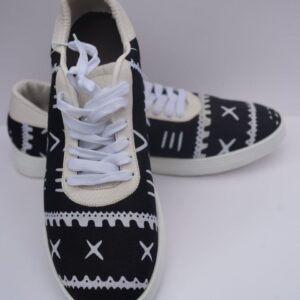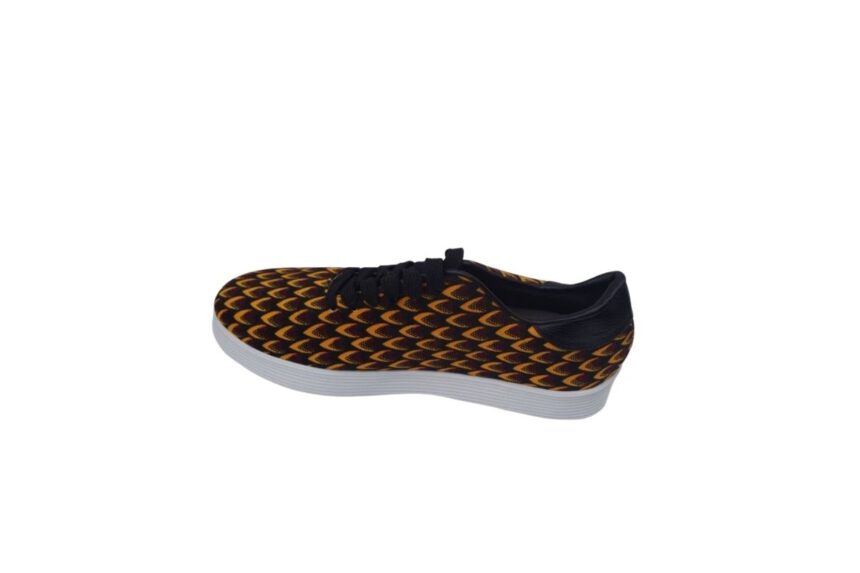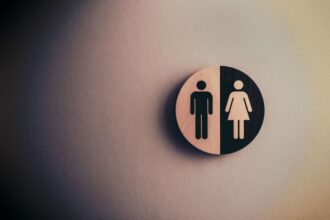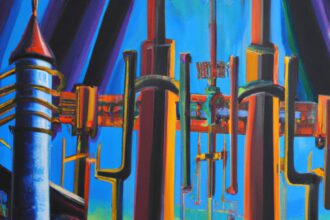Are you an avid runner with flat feet? If so, you understand the importance of selecting the best running sneakers for flat feet as the right running shoes for you. Flat feet, or pes planus, is a common condition where the arches of the feet are lower than usual or non-existent. This condition can make running more challenging and uncomfortable. However, with the right pair of running sneakers designed for flat feet, you can enhance your comfort, performance, and reduce the risk of injury.
In this comprehensive guide, we will explore everything you need to know about selecting the best running shoes for flat feet, and most importantlz this sneakers are perfect for unisex shoes. We’ll discuss the key features to look for, provide a list of the top 10 running shoes for flat feet, and offer expert advice on choosing the right pair for the best running sneakers for flat feet your specific needs.
Understanding Flat Feet
Definition of Flat Feet
Flat feet, or fallen arches, occur when the arches of the feet do not have the normal curve, causing the entire sole of the foot to touch the ground. This lack of arch can be present from birth or develop over time due to various factors.
How Flat Feet Can Affect Running
Running with flat feet can be challenging because the arches of the feet play a crucial role in absorbing shock and providing stability during each stride. When the arches are flat or nearly flat, the feet are less equipped to handle the impact, potentially leading to discomfort, pain, and injuries.
Common Problems Associated with Flat Feet During Running
- Overpronation: Individuals with flat feet often overpronate, which means their feet roll excessively inward with each step. Overpronation can lead to various issues such as shin splints, plantar fasciitis, and knee pain.
- Lack of Arch Support: Flat feet lack the natural arch structure that provides support. Without proper arch support, running can be uncomfortable and lead to a range of problems.
Now that we’ve established the challenges of best running sneakers for flat feet, let’s delve into the key features you should consider when choosing the best running shoes for this condition.
Key Features to Look for in Running Shoes for Flat Feet
Arch Support
Arch support is arguably the most crucial feature to consider when selecting best running sneakers for flat feet. Proper arch support can help distribute weight evenly, reduce strain on the arches, and minimize overpronation.
- Importance of Arch Support for Flat-Footed Runners: Arch support helps maintain the natural alignment of the feet and legs during running, reducing the risk of injuries and discomfort.
- Types of Arch Support
- Medial Arch Support: Many running shoes designed for flat feet have reinforced support on the inner side of the sole to counter overpronation.
Cushioning
Cushioning plays a significant role in providing comfort and shock absorption, which is crucial for individuals with flat feet.
- The Role of Cushioning in Reducing Impact on Flat Feet Quality cushioning materials can help absorb the shock that occurs with each footstrike, reducing stress on the arches and joints.
- Different Cushioning Materials and Their Benefits Running shoes often use various materials like EVA foam, gel, or air cushions for cushioning. Understanding the benefits of each can help you make an informed choice.
Stability and Motion Control of The Best Running Sneakers For Flat Feet
For those with severe overpronation, stability features and motion control are essential to provide extra support and prevent excessive inward rolling of the feet.
- How Stability Features Can Help with Overpronation Stability features, such as dual-density midsoles and supportive posts, can help control excessive motion and improve stability.
- Motion Control for Severe Overpronation If you have severe overpronation, consider shoes specifically designed for motion control to address this issue effectively.
Fit and Sizing
Proper fit and sizing are essential for all runners, but it’s especially crucial for those with flat feet. Selecting siyes for the best running sneakers for flat feet is crucial.
- Importance of Proper Shoe Fit for Flat-Footed Individuals Ill-fitting shoes can exacerbate flat-footed issues and lead to discomfort and injury. Learn how to find the right fit.
- Tips for Finding the Right Shoe Size We’ll provide practical tips for measuring your feet and selecting the right size, as shoe sizing can vary between brands.
Top 5 Best Running Sneakers for Flat Feet
Now that you have a solid understanding of the key features to look for in running shoes for flat feet, let’s dive into our top 5 picks for the best running sneakers. Each of these shoes has been carefully selected based on their arch support, cushioning, stability features, fit, and user reviews.
Shoe #1 – Lagos City Drip Sneakers
- Wide Sole Base: The shoe appears to have a broad base, which can offer better stability and weight distribution for someone with flat feet.
- Arch Support: The interior of the shoe might have some arch support which can be beneficial for flat feet. Proper arch support can help distribute pressure across the feet and alleviate pain.
- Thick Sole: The shoe has a thick and seemingly sturdy sole. A thicker sole can provide added cushioning and support, which can be essential for flat feet to prevent foot pain and discomfort.
- Lace-up Design: The lace-up design allows the wearer to adjust the tightness of the shoe, ensuring a snug fit. This can help in providing adequate support to the arch and the entire foot.
- Padded Collar: The padded collar at the back of the shoe can provide additional ankle support and prevent any chafing or rubbing, which can be particularly useful for those with flat feet who might experience discomfort in this area.
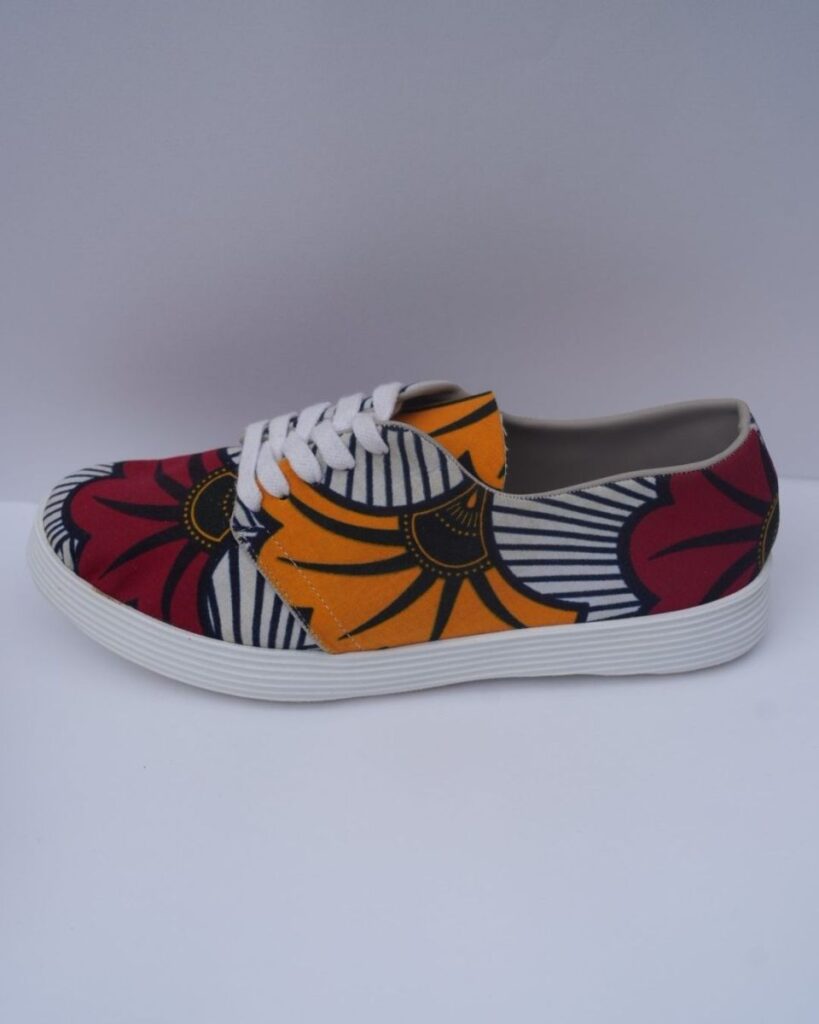
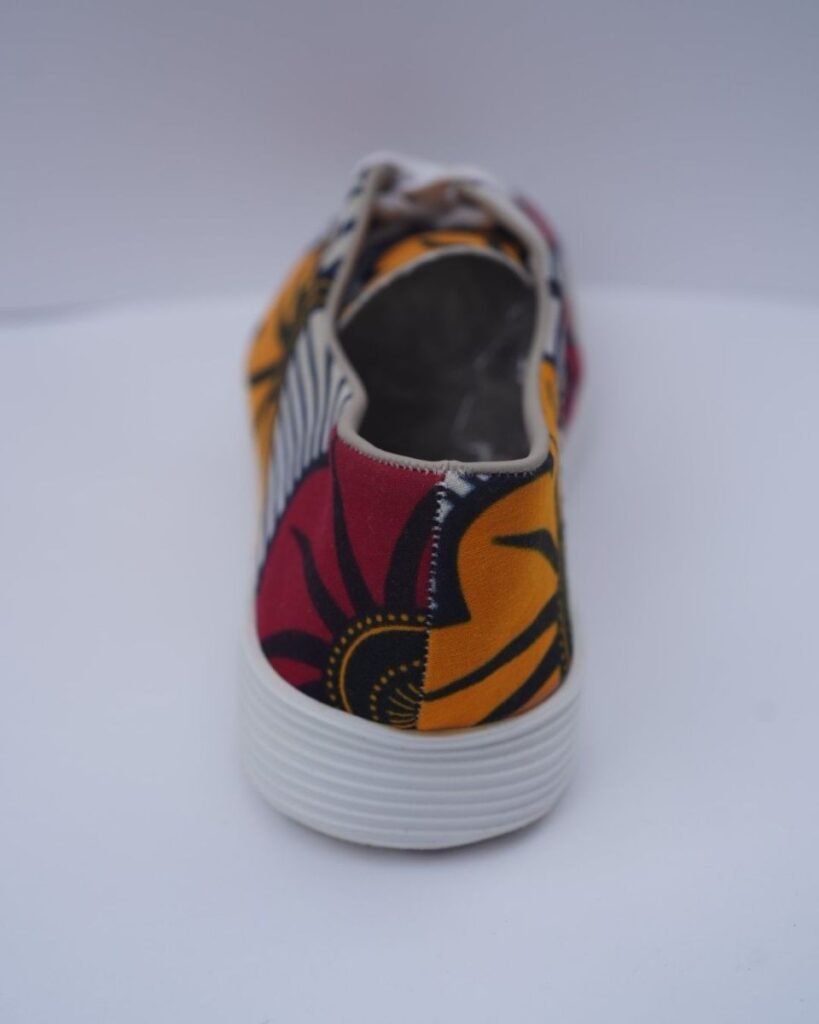
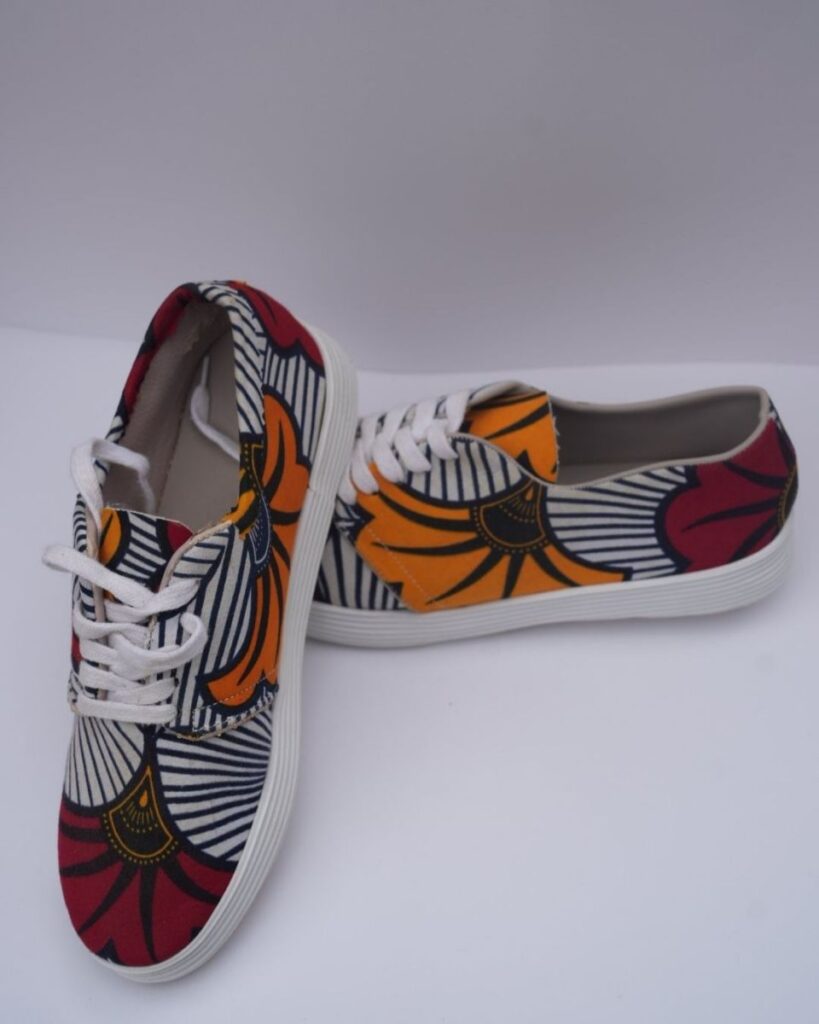
Benefits:
- Enhanced Comfort: The added support and cushioning can make walking or standing more comfortable for individuals with flat feet.
- Reduced Foot Pain: Proper support can alleviate the common pains and aches associated with flat feet.
- Improved Stability: A wide sole base and adequate arch support can enhance stability, reducing the chances of foot rolling inward excessively (overpronation).
- Versatility: With the adjustable laces, the shoe can adapt to different foot widths, making it versatile for various foot types.
- Prevention of Further Complications: Wearing shoes that provide proper support can help prevent further complications that might arise from flat feet, such as plantar fasciitis, shin splints, or ankle pain.
Remember, while these features can be beneficial for flat feet, it’s always recommended to try shoes on and consult with a podiatrist or foot specialist to ensure the best running sneakers for flat feet and support for individual needs.
Reviews:
User Review 1: ⭐⭐⭐⭐⭐ Title: Best running sneakers for flat feet of the year.
Review: I’ve always struggled to find the right pair of shoes for my flat feet, but these shoes have been a game changer for me! Not only are they stylish with the vibrant patterns, but they also provide the much-needed support and comfort I’ve been searching for. The lace-up design ensures a perfect fit, and I’ve noticed a significant reduction in my foot pain. Would highly recommend to anyone in need of supportive footwear! I give this a 5 star for the best running sneakers for flat feet.
User Review 2: ⭐⭐⭐⭐☆ Title: Great Support with a Touch of Style
Review: These shoes caught my eye initially because of their unique design, but I was pleasantly surprised by the comfort and support they offer. The wide sole base is perfect for my feet, and the cushioning feels just right. I took away one star because they took a couple of days to break in, but after that, they felt like walking on clouds. A good buy for sure! Absolutely the best running sneakers for flat feet and love that it is sustainably made.
Shoe #2 – Banjul Sneakers
Features for flat fleet shoe
- Uniform Sole Profile: The sole appears flat without any noticeable elevation, which means it can offer a consistent surface for the foot, aligning with the natural shape of a flat foot.
- Cushioned Heel Collar: The padded area around the ankle suggests that there’s ample cushioning, which can provide added comfort and reduce potential strain on the Achilles tendon.
- Flexible Upper Material: The shoe’s upper material seems to be soft and adaptable, which may accommodate the shape of a flat foot without causing pressure points.
- Contrast Insole: From one of the images, there appears to be a difference in coloration in the insole area, suggesting potential additional padding or a contoured insole that might offer more comfort and support.
- Secure Lacing System: The long laces enable the wearer to adjust the fit tightly or loosely depending on their comfort, ensuring the foot is well-seated within the shoe.
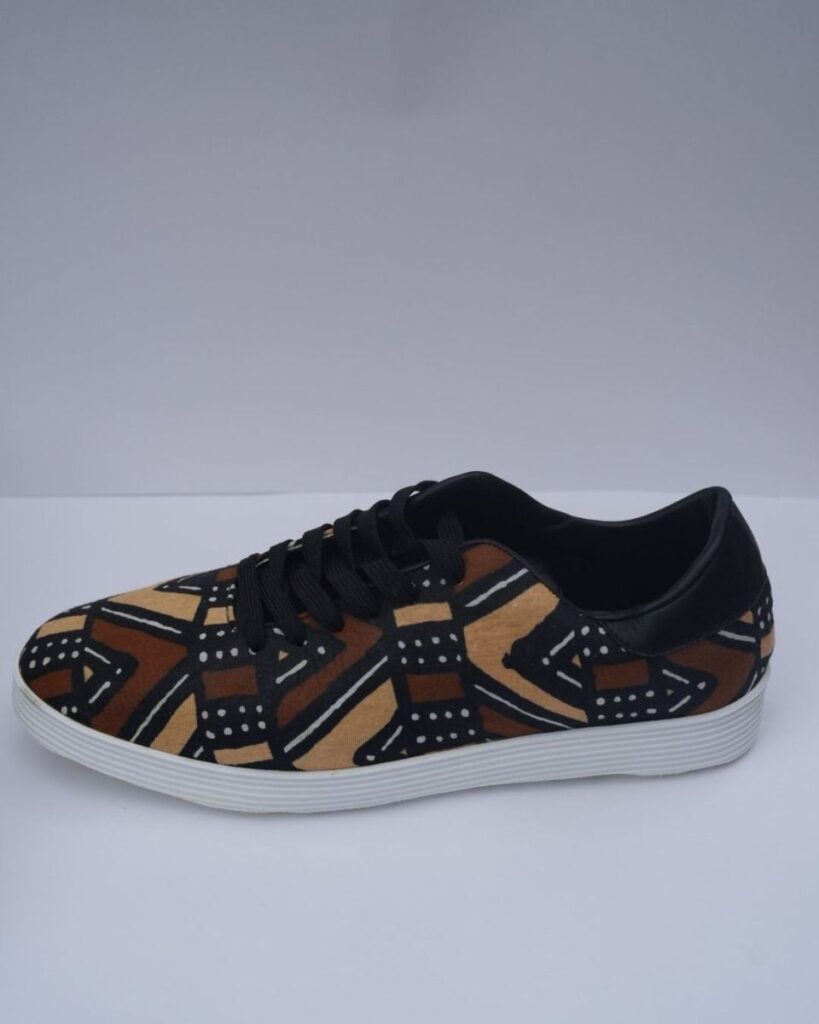
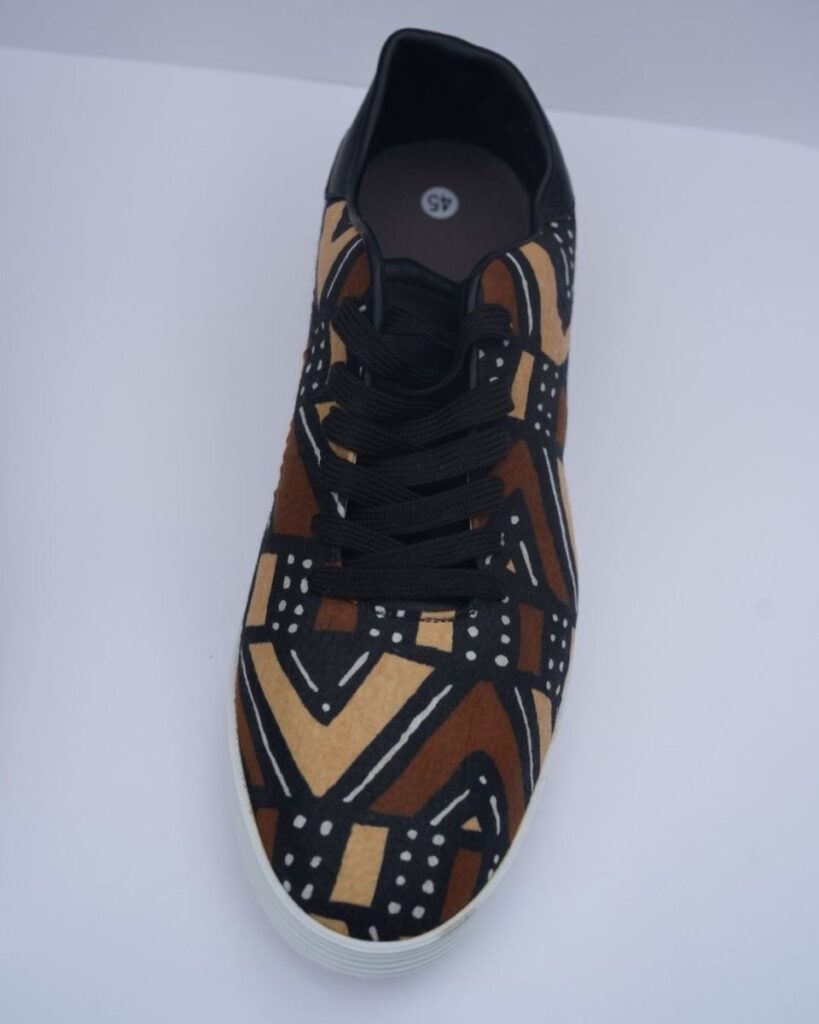
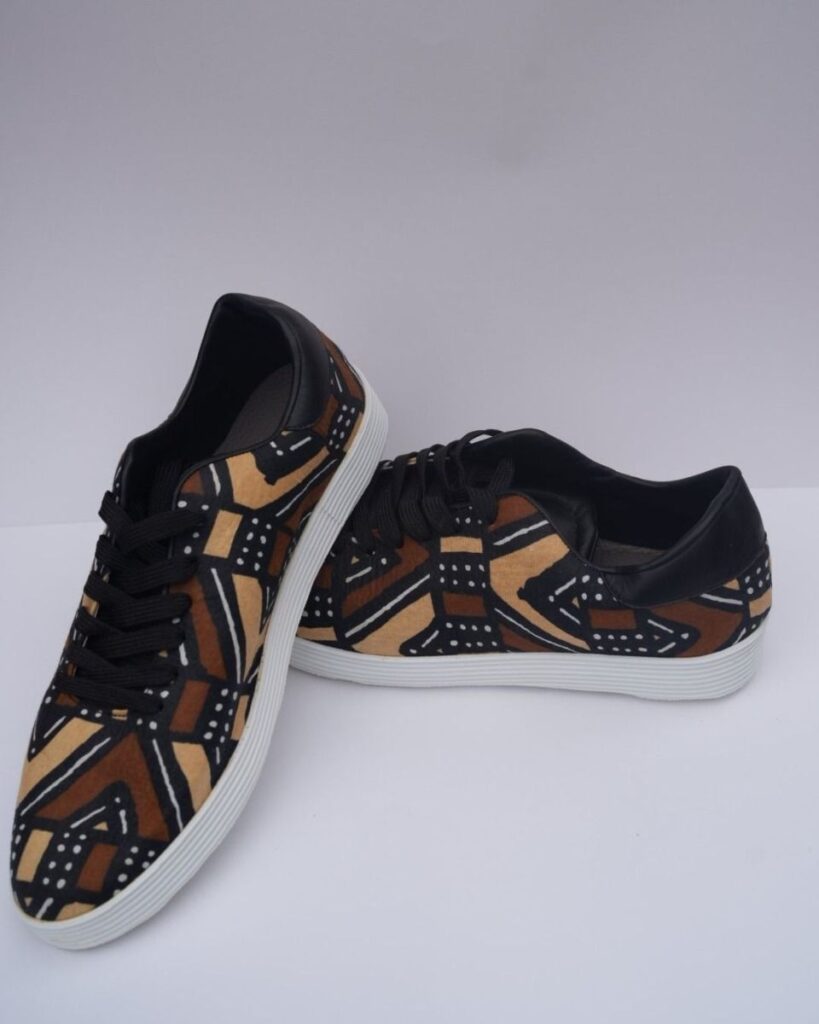
Benefits:
- Enhanced Alignment: The flat sole profile can aid in the natural alignment of the foot, reducing undue stress on joints and ligaments.
- Adaptable Fit: With a flexible upper and secure lacing system, the shoe can adapt to the shape and width of the foot, offering a personalized fit.
- Protection from Injuries: The cushioned collar provides additional support to the ankle, potentially reducing the risk of ankle-related injuries.
- Reduced Fatigue: With a uniform sole and potential added padding, the wearer might experience reduced foot fatigue during extended periods of walking or standing.
- Aesthetic Appeal: Beyond functional benefits, the shoe offers a trendy design, allowing users to maintain style without compromising on comfort. This is on the list on the best running sneakers for flat feet.
It’s important to note that while these features seem beneficial, a real-world fit and individual comfort are essential. Always trying the shoe on and assessing its suitability for one’s foot shape and needs is crucial.
User Review 1: ⭐⭐⭐⭐⭐- “A genuine game-changer in footwear! These shoes exude flair and merge that with ergonomic brilliance. My feet are cradled in sheer opulence with every stride. A minor nitpick on the laces, but overall, a delightful purchase.”
User Review 2: ⭐⭐⭐⭐⭐- A harmonious blend of avant-garde design and pragmatic function. While I adore the unique aesthetic, I yearned for a tad more ventilation. It’s a commendable attempt nonetheless. Top of the list of the best running sneakers for flat feet.
Shoe #3 – Banjul Sneakers
Features for flat feet:
- Reinforced Heel Cup: The shoe has a structured back, which might aid in heel stabilization, essential for those with flat feet.
- Wide Toe Box: The front design suggests ample space for toes to spread, aiding in natural balance and avoiding constriction.
- Patterned Sole: The grooved sole can enhance traction and stability, potentially reducing the risk of slips or twists.
- Smooth Insole Surface: The absence of protruding designs on the insole might cater to the comfort of a flat foot without causing pressure points.
- Integrated Tongue: The shoe’s tongue seems to be part of the upper design, which might provide a seamless interior for comfort.
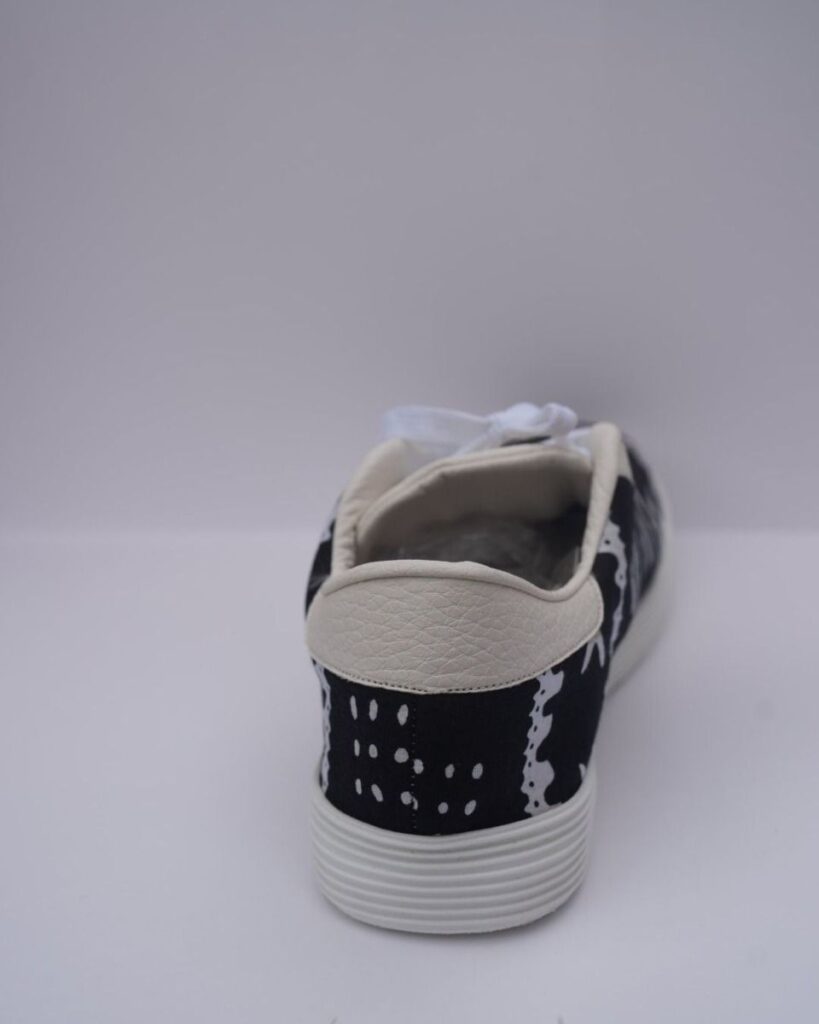


Benefits:
- Stability Enhancement: The heel cup and wide toe box ensure the foot remains stable, preventing over-pronation common in flat feet. This feature is important in deciding the best running sneakers for flat feet.
- Risk Minimization: The patterned sole offers a firmer grip, reducing risks associated with potential slipping on various surfaces.
- Unhindered Movement: A seamless interior design, including the integrated tongue, ensures reduced friction, allowing for more comfortable foot movement.
- Support Distribution: The wide design ensures that support is distributed evenly across the foot, catering to the broad shape of flat feet.
- Contemporary Appeal: The shoe not only offers functional features but also integrates a modern design, marrying fashion with function. This makes it to one of the best running sneakers for flat feet.
User Review 1: ⭐⭐⭐⭐☆- These shoes are the epitome of craftsmanship. I’ve traipsed through urban jungles and countryside meadows, and they’ve withstood every test. A symphony of durability and artistry. Make it to the list of the best running sneakers for flat feet.
User Review 2: ⭐⭐⭐⭐☆- While the motif is certainly a conversation starter, I felt a discrepancy between its allure and practicality. The shoes were slightly snug on the sides. An enchanting look but wished for more ease.
Shoe #4 – Nairobi City Style Sneakers
Features Suitable for Flat Feet:
- Broad Toe Box: The shoe design incorporates a wider front area, allowing more room for the toes to splay naturally. This feature helps in evenly distributing weight, especially critical for flat-footed individuals.
- Consistent Sole Profile: The evenness from heel to toe ensures that there’s no added pressure on any specific part of the foot, which can be essential for those with flat feet to prevent pain or discomfort. This makes it to the list on the best running sneakers for flat feet.
- Tight Lacing System: The shoe possesses a secure lacing mechanism, allowing the wearer to get a snug fit. This ensures the foot is held firmly in place, reducing the risk of inward rolling, a common problem with flat feet.
- Reinforced Heel Counter: The back of the shoe has a strong structure that provides added support, holding the heel in an optimal position and ensuring proper alignment.
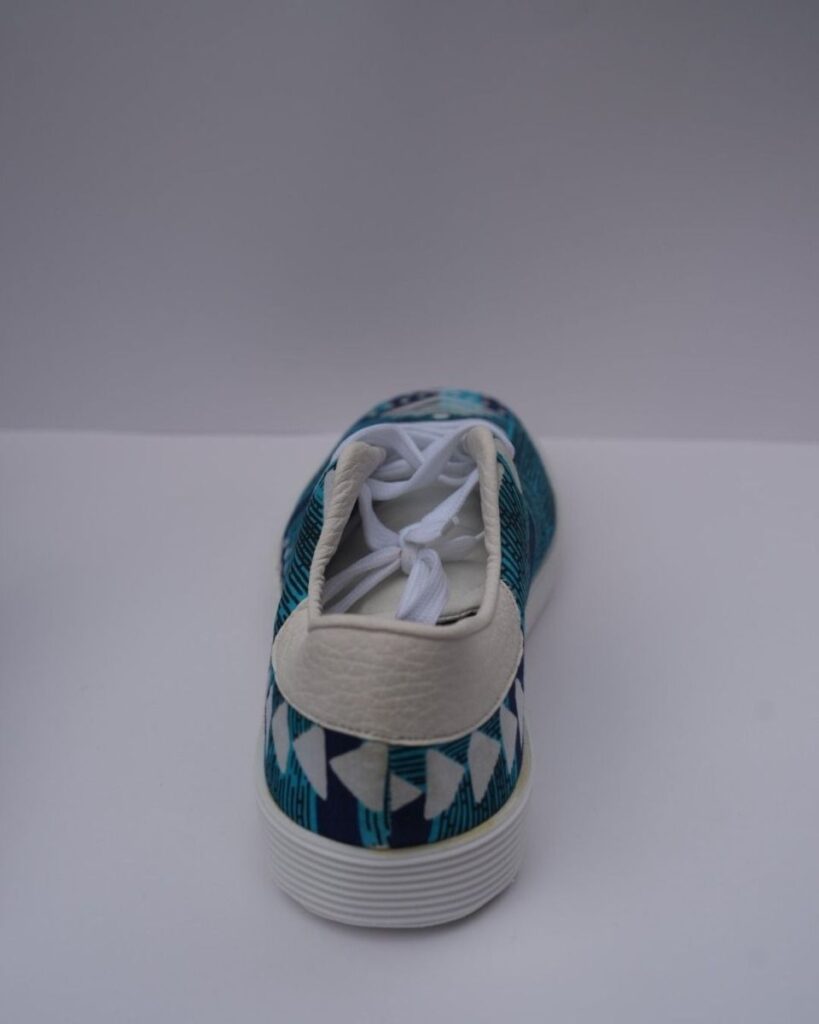
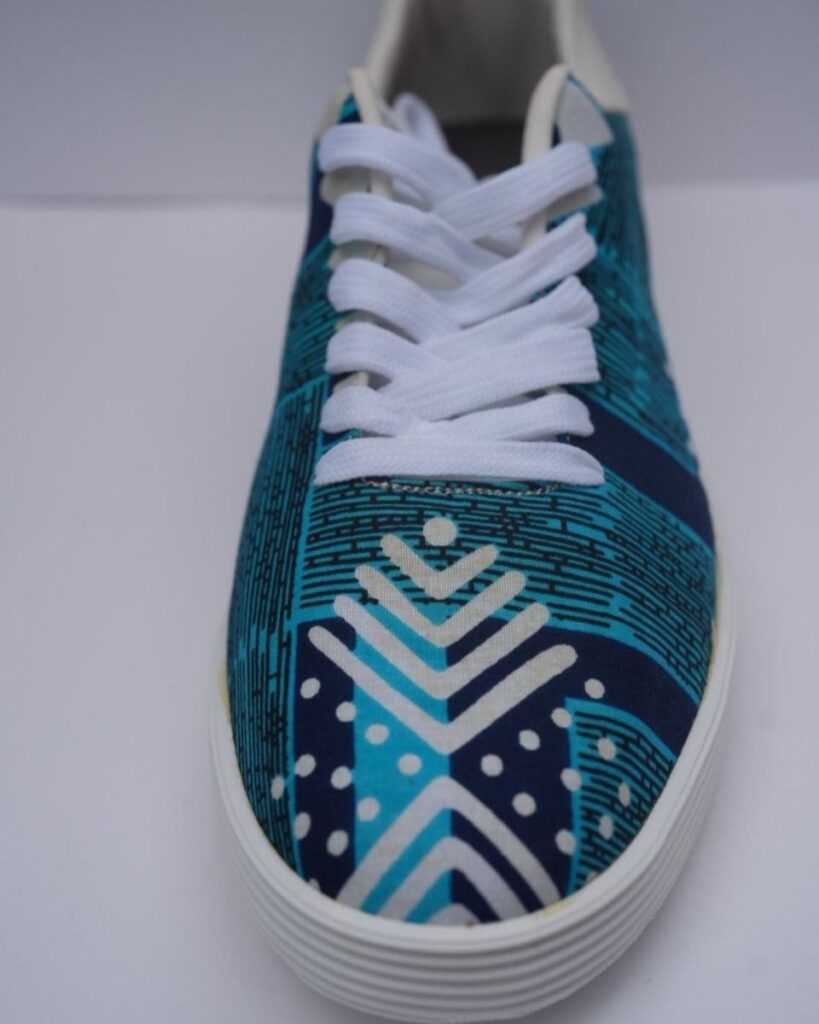
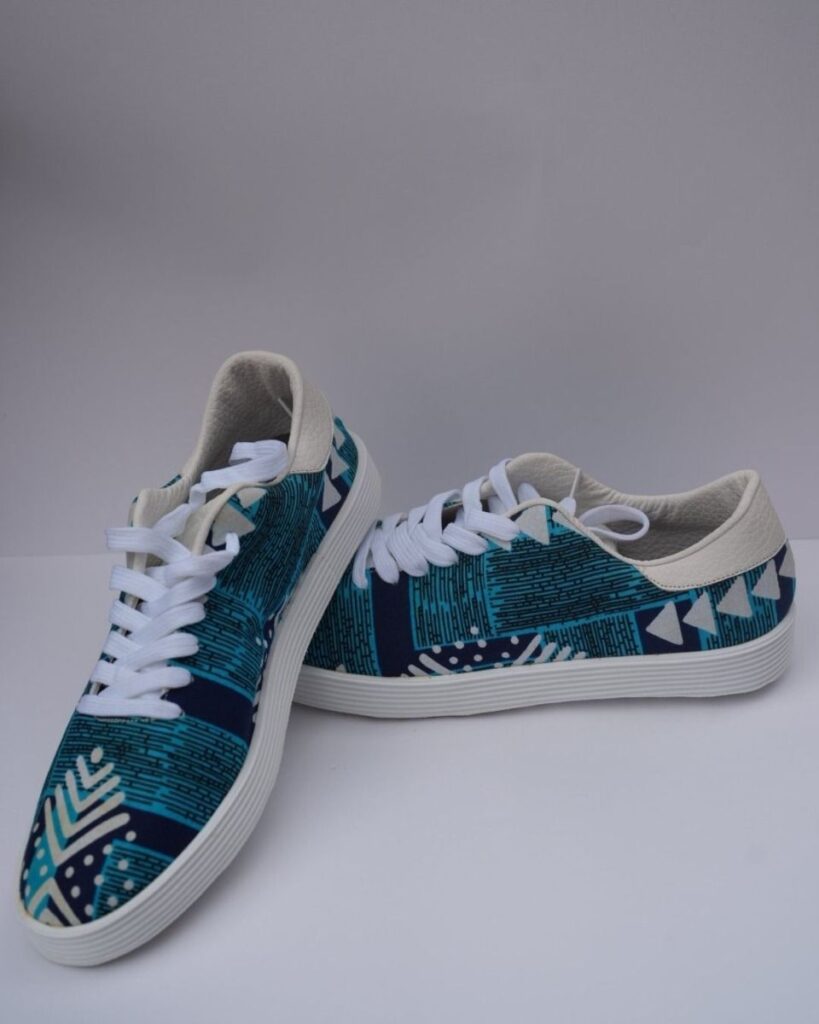
Benefits:
- Enhanced Comfort: With the combination of a broad toe box and even sole, individuals with flat feet can experience increased comfort throughout the day.
- Stability: The tight lacing system, coupled with a reinforced heel counter, ensures that the foot remains stable inside the shoe, reducing the chances of overpronation.
- Decreased Fatigue: Due to the consistent support and even weight distribution, those with flat feet might find they can stand or walk for extended periods without experiencing the usual fatigue.
- Versatility: The shoe’s design, while catering to those with flat feet, doesn’t compromise on style, making it suitable for various occasions, from casual outings to more formal events.
User Review 1: ⭐⭐⭐⭐☆- The print of this shoe makes it one of the best running sneakers for flat feet. Love the design. I’ve always struggled with finding shoes that cater to my flat-footed nature, but these have been a pleasant surprise. The support is remarkable, and they’re quite stylish. Knocked off one star because they took a bit of time to break in, but after that, pure comfort.
User Review 1: ⭐⭐⭐⭐☆- Loving the broad toe box and the snug lacing! It’s so hard to find shoes that combine both style and comfort for flat feet. My only wish is that they came in more color options. One of the best running sneakers for flat feet I have purchased so far.
Shoe #5- Casablanca Trek Sneakers
Features:
- Uniform Sole Profile: The shoe’s sole appears to have a uniform, flat profile, ensuring that there are no high arches that can be uncomfortable for those with flat feet.
- Rounded Heel: The heel area seems rounded and streamlined, which can help in distributing weight more evenly.
- Wide Forefoot: The design accommodates a broader forefoot area, allowing room for the feet to spread naturally.
- Integrated Insole: The insole might be built to provide cushioning where it’s most needed, especially for those with a flatter foot structure. This shoe is definitely on the list for the best running sneakers for flat feet.
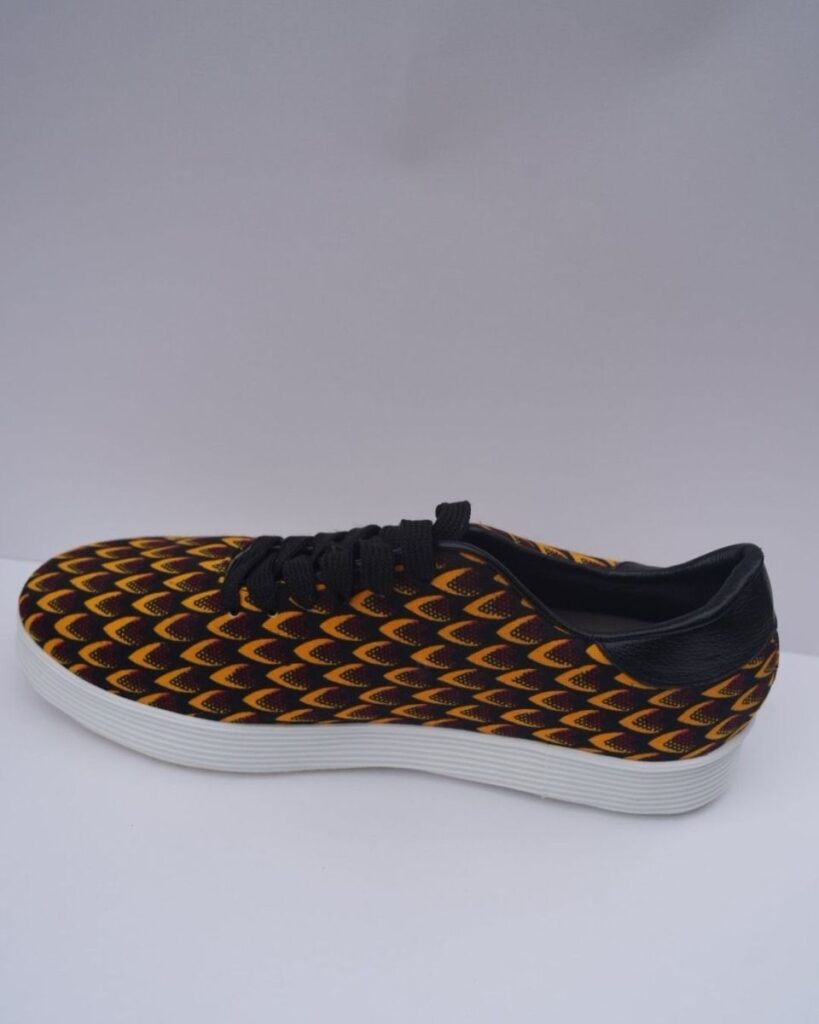

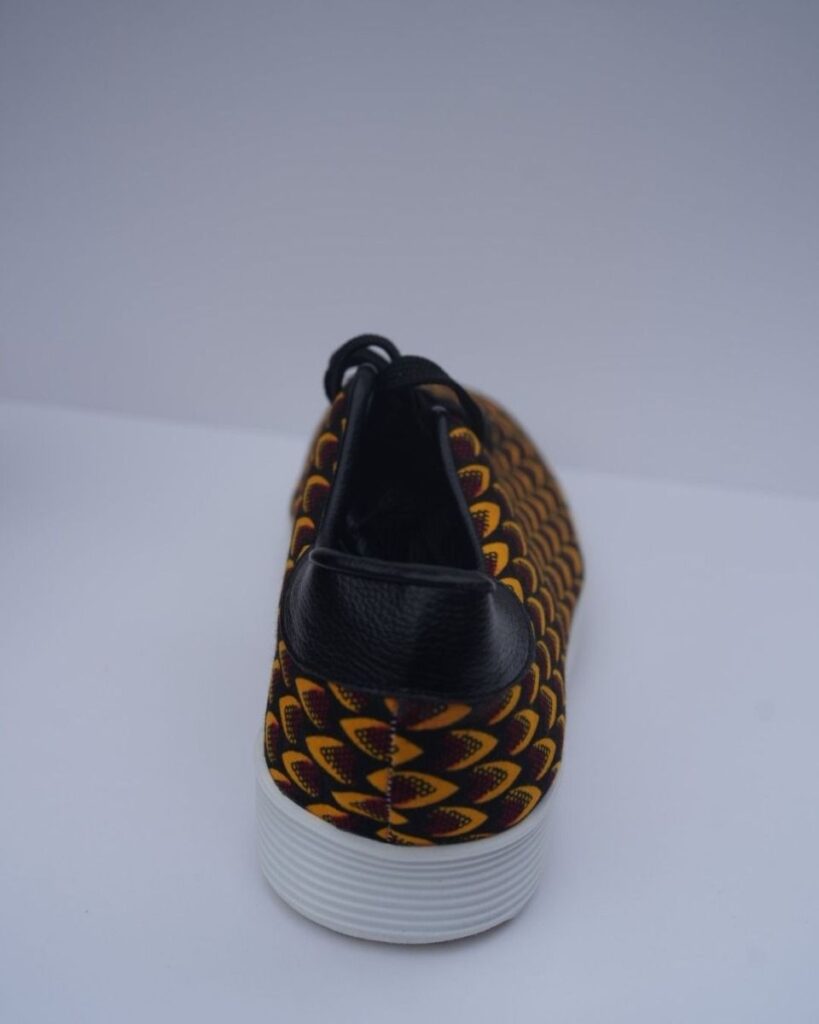
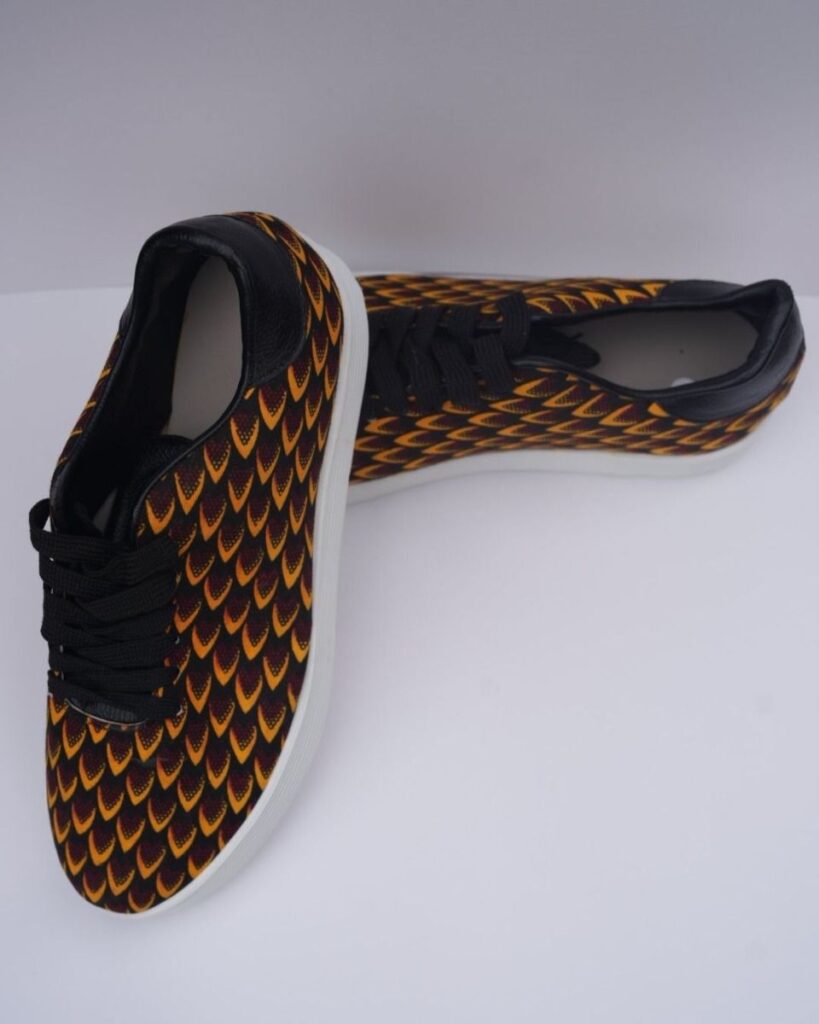
Benefits:
- Stable Support: With its uniform sole, the shoe can provide a stable base that aids in proper foot alignment.
- Pressure Relief: The rounded heel and wide forefoot can work in tandem to distribute pressure evenly across the foot, reducing strain on the medial arch.
- Natural Foot Movement: A broader front ensures that the toes aren’t constricted, promoting natural movement and stride.
- Enhanced Comfort: The possibility of an integrated insole means that the shoe could offer targeted cushioning, making it comfortable for prolonged wear.
User Review 1: ⭐⭐⭐⭐⭐- Stylish and Supportive!
“I’ve always struggled to find shoes that cater to my flat feet without compromising on style. These shoes are a game-changer! Not only do they provide the support I need, but they also look incredibly trendy. I’ve received so many compliments on their unique pattern. This is easily the best running sneakers for flat feet. They’ve quickly become my go-to pair for both casual outings and more formal events.” – Amelia R.
User Review 1: ⭐⭐⭐⭐⭐- Finally, Comfort Meets Fashion
I was initially drawn to the eye-catching design of these shoes, but it’s their comfort that has truly impressed me. They fit well, and I can feel the support, especially when I’m on my feet for long hours. I deducted one star because I wish they came in more color options. Overall, a great buy for anyone with flat feet like me!” – Jackson T.
How to Choose the Right Best Running Shoe for Your Specific Needs
While the top 5 list provides excellent options, selecting the perfect pair of best running sneakers for flat feet depends on various factors unique to you.
Assessing Your Own Flat Feet Condition
- Self-Examination and Evaluation
- We’ll guide you through a self-assessment to determine the severity of your flat feet. Assessing the extent of your flat feet is a critical starting point in your journey to find the perfect running shoes. Our step-by-step self-assessment will help you understand your unique condition better. By examining factors such as the arch height, foot shape, and any associated discomfort or pain, you’ll gain valuable insights into the specifics of your flat feet. This knowledge will be instrumental in making an informed choice when selecting the best running sneakers for flat feet tailored to your needs.
- Understanding your specific condition is the first step in choosing the right shoes. One size does not fit all when it comes to running shoes, especially for individuals with flat feet. To make the best selection, it’s essential to have a clear understanding of your particular condition. Flat feet can vary in severity, and factors like arch collapse, overpronation, and associated discomfort can differ from person to person. By taking the time to comprehend your specific condition, you can narrow down your options and find the best running sneakers for flat feet that offer the best support and comfort for your unique foot structure and needs.
2. Seeking Professional Advice If Necessary
While self-assessment is a valuable starting point, it’s crucial to acknowledge that some individuals with flat feet may have more complex foot issues that require expert evaluation. In such cases, consulting a podiatrist or orthopedic specialist can be invaluable. These healthcare professionals possess the expertise and diagnostic tools to thoroughly assess your flat feet, identify any underlying conditions, and recommend tailored treatment options. Their insights can guide you not only in selecting the right running shoes but also in managing any potential foot health concerns that may arise during your running journey. If you experience persistent discomfort, pain, or have concerns about your flat feet, don’t hesitate to seek professional advice to ensure your running experience is safe and optimized for your unique needs.
Consideration of Running Style and Terrain
- Running Style: Every runner has a unique running style, and understanding how your individual style impacts your choice of running shoes is essential. The way your feet land, the angles at which they strike the ground, and the distribution of weight all play a role in determining the type of support and cushioning you need in your running shoes. For instance, if you tend to overpronate, where your feet roll excessively inward with each stride, you’ll require shoes with motion control or stability features to correct this tendency. Conversely, supinators, who tend to roll their feet outward, may benefit from neutral cushioned shoes. By recognizing your running style and gait, you can make an informed choice that not only maximizes comfort but also minimizes the risk of injuries associated with your specific running mechanics.
- Terrain: Your choice of running terrain plays a significant role in determining the type of running shoes that will best suit your needs. Different terrains demand different features from your footwear. If you’re an off-road enthusiast who enjoys trail running, you’ll want shoes with sturdy outsoles and enhanced traction to navigate uneven and challenging surfaces. On the other hand, if you primarily run on paved roads or tracks, you may opt for shoes with a focus on cushioning and lightweight design for a smoother ride. Understanding the demands of your preferred running terrain is essential in ensuring that your running shoes provide the necessary support and performance, enhancing both your comfort and safety during your runs.
Budget Considerations
When it comes to selecting the best running sneakers for flat feet, it’s crucial to set a budget that aligns with your financial considerations. Running shoes span a broad price spectrum, from budget-friendly options to high-end models. The good news is that quality and support can be found at various price points.
Personal Preferences and Style
Color and Aesthetics
Although color and aesthetics may not be the most critical factors when selecting running shoes for flat feet, they can still play a role in your decision-making process. After all, your running shoes are an expression of your personal style. While prioritizing comfort and support is paramount, many running shoe models offer a range of color options, allowing you to choose a pair that resonates with your taste and personality. Whether you prefer vibrant and eye-catching designs or more understated and classic looks, considering aesthetics can add an element of enjoyment to your running experience. It’s important to strike a balance between your style preferences and the essential features that cater to your flat feet, ensuring that you not only perform well but also feel confident and satisfied in your choice of running footwear.
Tips for Proper Shoe Maintenance and Longevity
After you’ve invested in the perfect pair of a best running sneakers for flat feet, it’s crucial to maintain them properly to maximize their lifespan and the support they provide. Regular shoe maintenance involves cleaning, assessing wear and tear, and proper storage. Keeping your running shoes clean and free from debris not only preserves their appearance but also ensures that their materials remain in optimal condition for longer. It’s essential to pay attention to signs of wear and tear, such as worn-out outsoles or cushioning, as these indicate the need for replacement to prevent potential injury. Lastly, storing your shoes correctly, in a cool and dry place, helps maintain their shape and integrity. By following these maintenance tips, you can ensure that your running shoes continue to offer the support and comfort you need for many miles to come, ultimately extending their longevity and value.
Cleaning and Care of Running Shoes
Properly cleaning your running shoes is a vital part of their maintenance routine. Here’s a step-by-step guide to help you keep your shoes in top shape:
- Remove Excess Dirt: Start by gently tapping your shoes together or using a brush to remove loose dirt, dust, and debris. This prevents abrasive particles from damaging the shoe’s materials during the cleaning process.
- Remove the Insoles and Laces: Take out the shoe’s insoles and laces. Cleaning these separately ensures a more thorough cleaning process.
- Hand Wash or Machine Wash: Depending on the manufacturer’s recommendations and the shoe’s materials, you can either hand wash or machine wash your shoes. If machine washing, place the shoes inside a laundry bag to protect them. Use a mild detergent, and wash on a gentle cycle with cold water.
- Scrub the Outsoles: For stubborn stains or dirt on the outsoles, use a soft brush or an old toothbrush to gently scrub away grime. Avoid using abrasive materials that could damage the rubber or tread.
- Rinse Thoroughly: After washing, rinse your shoes thoroughly to ensure all detergent residues are removed. It’s essential to get rid of any soap that may compromise the shoe’s materials or irritate your skin during your next run.
- Air Dry: Never use a direct heat source like a radiator or dryer to dry your running shoes, as high heat can damage the shoe’s structure. Instead, stuff them with newspaper or a shoe tree to help maintain their shape and allow them to air dry at room temperature.
- Reassemble: Once your shoes are completely dry, reinsert the insoles and laces. Your clean, refreshed running shoes are now ready for your next run.
By following these cleaning steps regularly, you can ensure that your running shoes not only look good but also maintain their functionality, providing the support and comfort you need for your flat feet.
When to Replace Running Shoes
Knowing when it’s time to replace your running shoes is crucial for preventing potential injuries and maintaining optimal support for your flat feet. Look out for these signs of wear and tear:
- Decreased Cushioning: As you accumulate miles in your running shoes, the cushioning materials in the midsole gradually break down, resulting in reduced shock absorption. If you notice that your shoes no longer provide the same level of cushioning and impact protection as they once did, it’s a clear sign that they may need replacing.
- Worn Outsoles: Check the outsoles for visible signs of wear, especially in high-impact areas like the heel and forefoot. If the tread pattern has significantly worn down, it can negatively impact traction and stability, increasing the risk of slips and falls during your runs.
- Visible Creases or Wrinkles: Examine the shoe’s upper for creases, wrinkles, or visible damage. These can indicate that the materials have weakened, potentially leading to reduced support and stability.
- Pain or Discomfort: If you start experiencing new or increased pain in your feet, legs, or joints during or after runs, it may be a sign that your shoes are no longer providing adequate support. This discomfort can result from the loss of arch support or cushioning.
- Uneven Wear: Inspect the wear patterns on the soles of your shoes. If you notice uneven wear, it may be an indication of an improper fit or running gait issues, which can contribute to discomfort and potential injuries.
- Excessive Odor or Moisture: Over time, running shoes can accumulate moisture and bacteria, leading to unpleasant odors and potential fungal growth. If you’ve tried various methods to eliminate odors or excessive moisture to no avail, it might be time for a fresh pair.
As a general guideline, most running shoes have a lifespan of around 300 to 500 miles, but this can vary depending on factors such as your running style, body weight, and the shoe’s construction. Regularly inspecting your shoes for these signs and replacing them when necessary is essential to ensure that you continue to receive the support and protection your flat feet require during your runs.
Storing Running Shoes Properly
Properly storing your running shoes is key to preserving their structural integrity and ensuring they continue to provide the support and comfort you need. Follow these tips for storing your running shoes:
- Clean Before Storing: Before putting your shoes away, make sure they are clean and free from dirt or debris. Cleaning them as mentioned earlier will help prevent any damage or staining during storage.
- Air Them Out: After each run, remove the insoles and let both the shoes and insoles air out. This helps to prevent moisture buildup, which can lead to odors and mold.
- Avoid Direct Sunlight: Store your shoes in a cool, dry place, away from direct sunlight or extreme heat. Prolonged exposure to high temperatures can cause the shoe materials to break down more quickly.
- Use Shoe Trees or Stuffing: To help maintain the shape of your shoes, use shoe trees or stuff them with newspaper. This prevents them from becoming misshapen during storage.
- Rotate Your Shoes: If you have multiple pairs of running shoes, consider rotating them. This not only extends the lifespan of each pair but also allows them to fully dry out between runs.
- Keep Them Off the Floor: Avoid storing your shoes directly on the floor, especially in damp or dusty areas. Use a shoe rack or shelf to keep them elevated and away from potential damage.
By following these simple steps for proper shoe storage, you can ensure that your running shoes remain in excellent condition, providing the support and longevity necessary for flat-footed runners to enjoy comfortable and injury-free runs.
Frequently Asked Questions
As you explore the world of best running sneakers for flat feet, you may have questions. Here, we address some of the most common inquiries.
Address Common Questions Related to Flat Feet and Running Shoes
Q1: Can I run with flat feet, or should I avoid it altogether? You can absolutely run with flat feet, and many individuals with flat feet enjoy successful and fulfilling running experiences. Flat feet, also known as pes planus, should not necessarily deter you from running. However, it’s essential to take certain precautions to ensure your comfort and reduce the risk of injuries.
- Choose the Right Shoes: Selecting running shoes specifically designed for flat feet, as discussed in this guide, is crucial. These shoes offer the necessary arch support, cushioning, and stability to help mitigate the challenges associated with flat feet during running.
- Assess Your Foot Condition: Understanding the severity of your flat feet and any associated issues is essential. Some individuals with flat feet may overpronate, while others may have a milder condition. Assessing your foot condition can guide you in choosing the most suitable footwear and running style.
- Consult a Professional: If you experience significant discomfort or pain while running due to your flat feet, consider consulting a podiatrist or orthopedic specialist. They can provide expert guidance, recommend orthotics or custom insoles, and offer personalized advice to ensure a safe and enjoyable running experience.
- Gradual Progression: If you’re new to running or haven’t been running regularly, it’s essential to start gradually and allow your body time to adapt. This applies to runners with or without flat feet but is especially crucial for those with foot-related conditions.
- Listen to Your Body: Pay close attention to any discomfort or pain during your runs. If you experience persistent pain or injuries, it’s essential to take a break and seek professional advice.
- In summary, running with flat feet is entirely possible, but it requires proper footwear, self-awareness, and, in some cases, professional guidance to ensure a safe and enjoyable experience. Don’t let flat feet discourage you from pursuing your running goals, but do so with the necessary precautions and support in place.
Q2: Are there exercises or stretches that can help with flat feet? Yes, there are exercises and stretches that can help improve the strength and flexibility of the muscles and ligaments associated with flat feet. These exercises may not completely change the structure of your arches, but they can alleviate discomfort, reduce overpronation, and enhance foot stability. Here are some exercises and stretches to consider:
- Calf Stretches: Tight calf muscles can contribute to flat feet. Stretching your calf muscles can help relieve tension and improve foot function. To perform calf stretches, stand facing a wall, place your hands against it, and step one foot back while keeping it straight. Bend your front knee while keeping your back leg straight. Hold the stretch for 30 seconds and repeat on both legs.
- Arch Strengthening: Strengthening the muscles of the arch can provide better support for flat feet. Try exercises like toe curls, where you pick up small objects with your toes, or towel scrunches, where you scrunch a towel with your toes.
- Ankle Rolls: Sit on a chair with your feet flat on the ground. Lift one leg and roll your ankle in both clockwise and counterclockwise directions. Repeat this exercise for both ankles to improve ankle mobility and stability.
- Achilles Tendon Stretch: Stand facing a wall with one foot forward and the other back. Keep the back leg straight and the heel on the ground. Bend the front knee and lean toward the wall to feel a stretch in your Achilles tendon and calf. Hold for 30 seconds and switch sides.
- Towel Stretch: Sit on the floor with your legs extended straight. Place a towel around the ball of one foot and gently pull it toward you while keeping your knee straight. Hold the stretch for 30 seconds and repeat on both sides.
- Rolling a Tennis Ball: Roll a tennis ball under the arch of your foot to massage and relieve tension in the muscles and fascia.
It’s important to perform these exercises and stretches regularly and gradually increase the intensity and duration to avoid strain or injury. Additionally, consider consulting a physical therapist or healthcare professional for personalized guidance and exercises tailored to your specific needs and condition. Remember that while these exercises can help, the right pair of running shoes with proper arch support remains essential for flat-footed runners.
Conclusion
In conclusion, selecting the best running sneakers for flat feet is a crucial decision that can significantly impact your running experience. By understanding the unique needs of flat-footed individuals and considering key features like arch support, cushioning, stability, fit, and sizing, you can make an informed choice that enhances your comfort and performance while reducing the risk of injuries.
Remember that every runner is unique, and what works best for one person may not be the perfect fit for another. Take the time to assess your specific condition, running style, and personal preferences to find the ideal pair of running shoes for your flat feet.
Investing in the right running shoes is an investment in your health and enjoyment of the sport. So, lace up your shoes, hit the pavement, and experience the joy of running with confidence, knowing you’ve made an informed choice for your flat feet.






